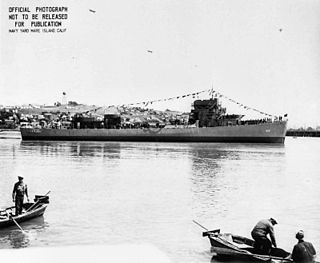
USS Mustin (DD-413) was a Sims-class destroyer of the United States Navy, the first Navy ship of that name, in honor of Captain Henry C. Mustin (1874–1923), a pioneer of naval aviation.

The third USS Farragut (DD-348) was named for Admiral David Glasgow Farragut (1801–1870). She was the lead ship of her class of destroyers in the United States Navy.

USS Abercrombie (DE-343) was a John C. Butler-class destroyer escort in the service of the United States Navy from 1944 to 1946. She was finally sunk as a target in 1968.

USS Du Pont (DD–152) was a Wickes-class destroyer in the United States Navy during World War II, later reclassified as AG-80. She was the second ship named for Rear Admiral Samuel Francis Du Pont.

USS Crosby (DD–164) was a Wickes-class destroyer in the United States Navy during World War II, later reclassified as APD-17. She was named for Admiral Peirce Crosby.

USS Darby (DE-218) was a Buckley-class destroyer escort in service with the United States Navy from 1943 to 1947 and from 1950 to 1968. She was sunk as a target in 1970.

USS Bowers (DE-637/APD-40) was a Buckley-class destroyer escort of the United States Navy, was named in honor of Ensign Robert K. Bowers (1915-1941), who was killed in action aboard the battleship USS California during the Japanese attack on Pearl Harbor on 7 December 1941. The ship was laid down on 28 May 1943 at San Francisco, California, by the Bethlehem Steel Company; launched on 31 October, sponsored by Mrs. Eunice Bowers, the mother of Ensign Bowers; and commissioned on 27 January 1944. The ship served in World War II in the Pacific

USS Bebas (DE-10) was an Evarts-class destroyer escort in the service of the United States Navy from 1943 to 1945.

USS Doherty (DE-14) was an Evarts class destroyer escort constructed for the United States Navy during World War II. She was sent off into the Pacific Ocean to protect convoys and other ships from Japanese submarines and fighter aircraft. She performed escort and antisubmarine operations in dangerous battle areas and returned home safely at war's end.

USS Halloran (DE-305) was a Evarts-class destroyer escort of the United States Navy.

USS Emery (DE-28) was an Evarts-class destroyer escort constructed for the United States Navy during World War II. It was promptly sent off into the Pacific Ocean to protect convoys and other ships from Japanese submarines and fighter aircraft. By the end of the war, she had accumulated three battle stars.

USS Dionne (DE-261) was an Evarts-class destroyer escort of the United States Navy during World War II. She was sent off into the Pacific Ocean to protect convoys and other ships from Japanese submarines and fighter aircraft. She performed escort and antisubmarine operations in dangerous battle areas and returned home with six battle stars, a high number for a ship of her type.

USS Canfield (DE-262) was an Evarts-class destroyer escort constructed for the United States Navy during World War II. She was sent off into the Pacific Ocean to protect convoys and other ships from Japanese submarines and fighter aircraft. She performed escort and antisubmarine operations in dangerous battle areas and returned home with four battle stars.
USS Connolly (DE-306) was an Evarts-class destroyer escort of the United States Navy during World War II. She was sent off into the Pacific Ocean to protect convoys and other ships from Japanese submarines and fighter aircraft. She performed escort and antisubmarine operations in dangerous battle areas and returned home with two battle stars.

USS Tills (DE-748) was a Cannon-class destroyer escort in service with the United States Navy from 1944 to 1946 and from 1950 to 1968. She was sunk as a target in 1969.

USS George E. Davis (DE-357) was a John C. Butler-class destroyer escort acquired by the U.S. Navy during World War II. The primary purpose of the destroyer escort was to escort and protect ships in convoy, in addition to other tasks as assigned, such as patrol or radar picket.

USS John L. Williamson (DE-370) was a John C. Butler-class destroyer escort acquired by the U.S. Navy during World War II. The primary purpose of the destroyer escort was to escort and protect ships in convoy, in addition to other tasks as assigned, such as patrol or radar picket.

USS Silverstein (DE-534) was a John C. Butler-class destroyer escort in service with the United States Navy from 1944 to 1947 and from 1951 to 1958. She was sold for scrapping in 1973.

USS Loeser was a Buckley-class destroyer escort of the United States Navy, named in honor of Lieutenant Commander Arthur E. Loeser (1903–1942).

USS Gillette (DE-681) was a Buckley-class destroyer escort of the United States Navy in service from 1943 to 1947. She was finally scrapped in 1973.



















